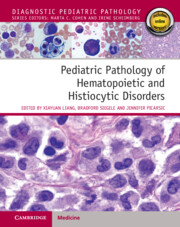Book contents
- Pediatric Pathology of Hematopoietic and Histiocytic Disorders
- Pediatric Pathology of Hematopoietic and Histiocytic Disorders
- Copyright page
- Epigraph
- Contents
- Contributors
- Section I General Hematology and Hematopathology
- Section II Non-Neoplastic Hematologic Disorders of Blood and Bone Marrow
- Section III Non-Neoplastic Disorders of Extramedullary Lymphoid Tissues
- Section IV Neoplastic Disorders of Bone Marrow
- Section V Mature Lymphoid Neoplasms
- Chapter 20 Mature B-Cell Non-Hodgkin Neoplasms
- Chapter 21 Mature T-Cell and NK-Cell Non-Hodgkin Lymphomas
- Chapter 22 Hodgkin Lymphoma
- Chapter 23 Immunodeficiency-Associated Lymphoproliferative Disorders
- Section VI Histiocytic Disorders and Neoplasms
- Index
- References
Chapter 22 - Hodgkin Lymphoma
from Section V - Mature Lymphoid Neoplasms
Published online by Cambridge University Press: 25 January 2024
- Pediatric Pathology of Hematopoietic and Histiocytic Disorders
- Pediatric Pathology of Hematopoietic and Histiocytic Disorders
- Copyright page
- Epigraph
- Contents
- Contributors
- Section I General Hematology and Hematopathology
- Section II Non-Neoplastic Hematologic Disorders of Blood and Bone Marrow
- Section III Non-Neoplastic Disorders of Extramedullary Lymphoid Tissues
- Section IV Neoplastic Disorders of Bone Marrow
- Section V Mature Lymphoid Neoplasms
- Chapter 20 Mature B-Cell Non-Hodgkin Neoplasms
- Chapter 21 Mature T-Cell and NK-Cell Non-Hodgkin Lymphomas
- Chapter 22 Hodgkin Lymphoma
- Chapter 23 Immunodeficiency-Associated Lymphoproliferative Disorders
- Section VI Histiocytic Disorders and Neoplasms
- Index
- References
Summary
Hodgkin lymphoma (HL) is a family of unique B-lineage lymphoma subtypes and encompasses two morphologically, immunophenotypically, and clinically distinct categories: classic Hodgkin lymphoma (CHL) and nodular lymphocyte-predominant Hodgkin lymphoma (NLPHL). HL usually affects the lymph nodes and is composed of a small number of large, dysplastic mononuclear and multinucleated neoplastic cells (Hodgkin/Reed-Sternberg [HRS] cells, or lymphocyte-predominant [LP] cells/lymphocytic and histiocytic [L&H] cells) set in the background of benign inflammatory elements with or without abundant band-like and/or more diffuse collagen fibrosis. The neoplastic cells are often surrounded by T-lymphocytes [1,2].
The difference between NLPHL and CHL is that the B-cell program is generally preserved, and the neoplastic cells exhibit the overt B-lineage phenotype in NLPHL, but the neoplastic cells in CHL display an aberrant differentiation program with a characteristic CD15+, CD30+, and CD45– immunophenotype [1,2].
- Type
- Chapter
- Information
- Pediatric Pathology of Hematopoietic and Histiocytic Disorders , pp. 285 - 295Publisher: Cambridge University PressPrint publication year: 2024

